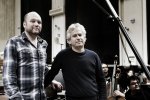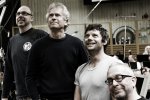“Sixes and Sevens” - the orchestral works of Tony Banks re-evaluated by Alan Hewitt.
As the only member of Genesis with any formal musical training, it was only a matter of time I suppose before Tony embarked upon compositions of a more “serious” nature than that of the Prog/Pop which formed the backbone of his musical career within Genesis. Even so, he took his time in doing so, which. Given the perils associated with rock musicians and “proper” music this was perfectly understandable I guess.
His first foray into the world of orchestral music came from an unlikely source as Tony recalls… “Well, the guy from Atlantic Records, Phil Carson was approached by Michael Winner. He had already done something with Jimmy Page and he said: ‘Do you know anyone who might want to do this film thing?’ and Phil Carson said: ‘This guy Tony Banks, he wants to do it’. So, he came to me and I admit I wasn’t a hundred percent sure about it but I decided to do it anyway. I worked on that particularly as it was going to be an orchestral soundtrack …”
Being his first attempt in this field, Tony was very much guided by the orchestrator/conductor (Christopher Palmer) and he had a large influence on it as Tony recalls… “So in a sense, a lot of what you hear is really him in terms of what the orchestrations are. …” The initial process was similar to what it would be if Tony were working with the band… “With a lot of the pieces I just played them on the piano and recorded them and then Christopher orchestrated them. Some of them very faithfully and others he adapted perhaps more than he should have done but it was great fun to do and all the main themes sounded great with the orchestra and in contrast to \The Shout, it had the music up front and when I saw it at the cinema it sounded great and that made me want to do more…”
The creative process for this album was also different to the methods Tony was used to as he recalled…
“I was there for all of the recordings but I didn’t get involved directly. Everything was done through Christopher Palmer who was the orchestrator. Working with people that are professionals in this field, it’s a different approach. They look at the music differently to how I would and that’s what’s great about it. It’s one take and it’s there and it sounds fantastic. There’s none of this overdubbing and cheating (laughs)…”
The film itself, as was usual with a Michael Winner production, courted a small degree of controversy around the duel scene between the two main female protagonists which, instead of pistols at dawn involved the injudicious use of bullwhips and cleavage - shades of the “Bare breasted and each carrying an eight pound baby” moment from a Blackadder episode a few years later but this IS Michael Winner we are talking about. The film received minimal interest at the time and since which is a shame as it is actually not that bad an effort and more importantly from our perspective, the music was well used and prominent throughout unlike so many films where the music is very much the servant of the image. |
|
Tony’s subsequent attempts at film score writing (Lorca And The Outlaws and Quicksliver) met with dismal failure despite the latter even featuring the appearance of Fish from Marillion whose star was very much in the ascendant at the time and neither film even made it to DVD. The music however, did surface in the shape of the Soundtracks album in 1986 which featured most of the recorded music from both films and makes for an interesting comparison between the more usual keyboard driven themes of these tracks and those of their orchestral predecessor.
And that appeared to be that in terms of composing for an orchestra as far as Tony was concerned. The rest of the 1980’s and ‘90’s were very much occupied with the ongoing career of Genesis as well as Tony’s own attempts to gain the commercial solo success which had thus far eluded him and a string of extremely well composed and yet poorly received albums ensued.
With Genesis effectively being on hiatus if not to say extinct as the twentieth century turned into the twenty first, the time was ripe for Tony to embark once again on orchestral composition and Tony recalls how the initial idea came about…
“After Calling All Stations I was just writing in the normal way I do and I had this thing, this idea, which was all done on a string synthesiser and I thought rather than try and make it into something I would do myself, I thought what about the idea of doing it with real strings and see how it sounds. Once I had got that idea in my head I thought… Oh, lets see what else you can do. And I started writing some other pieces specifically thinking in those terms….”
The creative process for a project with an orchestra was quite different too as Tony recalls… “The main difference was at the recording stage just that, the recording thing. You record the whole thing in two or three days and you are recording it with an orchestra who have never heard it before and they have to learn it. Also you are hearing it back for the first time with real instruments and there are so many changes you have to make and there are typographical errors and all of these things take time. And I said this in the album sleeve notes, after three hours you have to have ten minutes of music done otherwise you have failed….”
The album was a quantum leap in terms of what had preceded it and it was evident immediately that Tony had learned a great deal from his previous experience in this field and had built upon it although Tony, being the perfectionist that he is, admitted that the end result was still not quite as he had hoped… |
|
“I did the first sessions and that is why they didn’t turn out as well as they could, it was rushed and I didn’t really know all the sorts of things I would have to get together … there was so much talk about and you found yourself constantly saying ‘you’ve got to change this…’ and it was so negative and I didn’t get it the way I intended to really…”
To listeners this might seem hard to comprehend as the album is a much more rounded and mature result than anyone had any right to expect for a first attempt in this difficult field. |
|
Tony told me at the time of its release that he was in no hurry to do another one, but wanted to get an orchestral project under his belt before he finally hung up his boots (as he put it) and so it was to be a further seven years (intentional delay there perhaps?) before he undertook a further project of this nature. Continuing the numerically downward trend, this one was called Six Pieces For Orchestra and appeared in 2011. Tony took everything he had learned from that project on board as he explained to TWR…. “It had been in my mind since I finished Seven. I wanted to do another one because I felt I learned a lot on that project and I felt I could certainly do a more complete piece. Because there were so many things I didn’t understand until I got into the studio with everything that was happening and as you know from before, I had to do everything twice with Seven, three or four pieces ended up being done twice which taught me a lot in itself. So this time I was much better prepared….”
| Tony took himself off to Prague to work with the City Of Prague Orchestra. This was both a money and time saving exercise as he explains… “Well the main reason was because I knew I could get a lot more time with them for the same money. As you know, making these things is quite expensive and my experience with the LPO… they are a good orchestra but the time was a big factor and I didn’t feel that the orchestra was all that excited by it. So there was no reason to go that way again and someone said to me why not try the Prague orchestra, they were very good players and you could do the whole thing much cheaper which meant that I had more time to rehearse which was what I really missed last time…. The first thing you need to do is get the scores in front of them and get rid of all the bum notes! (laughs). That all worked out very well and this orchestra was much more enthusiastic for the music and much more excited about the idea and quite a few of them were Genesis fans which helped quite a bit and so in the main altogether it was a much happier experience…” |
|
The resulting album too was a much more satisfying result all round showing Tony’s growing command of the necessities of orchestral work.
| Fans bemoaning the fact that his first essay in the craft, The Wicked Lady, remained unreleased on CD were delighted when in 2013 Tony finally relented and issued the album on CD on his own Fugitive Inc label. The album finally brought the orchestral and demo versions of the album together which made for an interesting comparison between the two modes of working. It also showed that the soundtrack was a far stronger and coherent one than might have been appreciated at the time. Sadly the disc was only available for a short time before being deleted leaving this album, alongside several others from Tony’s back catalogue out in the cold. The reissues programme by Esoteric Records which began so magnificently with the release of A Curious Feeling, The Fugitive and the superb A Chord Too Far box set currently seems to have stalled. |
|
|
However, for fans of Tony’s orchestral work, the recent release of “5” takes his work in this field to yet another height and you can read more about the album in the interview which was published in our previous edition.



